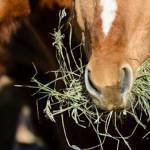A Close Look at Vitamin A in Equine Diets

A complete diet for horses includes all of the nutrients necessary for top-notch health. Vitamins are complex organic compounds that are essential to normal metabolism, and they are especially important in tissue repair following injury or illness. Each vitamin has several key roles in proper body function.
Several chemical compounds known as retinoids are grouped together and known collectively as vitamin A. This vitamin is necessary for growth and overall health in horses, playing a key role in the development and maintenance of bones and connective tissue. Vitamin A is vital to the proper function of osteoclasts, which are responsible for resorption and remodeling of bone. Without vitamin A, excessive deposition of periosteal bone occurs from the unchecked action of osteoblasts. Vitamin A is necessary for collagen synthesis and cross-linking so it is important for tendon and ligament strength. Retinoic acid, one of the active forms of vitamin A in the body, can synergize with thyroid hormones or glucocorticoids to enhance growth hormone secretion. Growth hormone has been shown experimentally to enhance the healing process in soft tissue injuries.
Green forage is the natural source of this vitamin for horses. Vitamin A itself does not occur in plant products but carotenes, the precursors that can be transformed into active forms of the vitamin, are found in abundance. Only about 20 of the more than 600 forms of carotene fall into this provitamin class, and even the most biologically active (beta-carotene) has a very low conversion rate. Conversion takes place in the intestinal mucosa and to a lesser extent in the liver and adipose tissue. The rate of conversion is affected by factors such as the horse’s vitamin A status, level of intake, age, activity level, and the environmental temperature.
Horses grazing high-quality pastures during the growing season are easily receiving their full vitamin A requirement in the form of carotene. Horses that are fed recently baled green alfalfa (lucerne) hay might also be getting enough of this vitamin. However, much of the carotene content is destroyed by oxidation in the process of curing hay. After two or three months, hay contains only a low level, and horses are rarely able to absorb sufficient quantities of beta-carotene from hay.
Vitamin A is stored in the horse’s liver, so brief periods without access to green forage will not have a detrimental effect. During the course of a winter with greatly reduced intake of fresh forage, vitamin A levels continue to fall and may take several months to build up even after the horse is turned out on pasture. Feeding a fortified grain product at the recommended level will provide vitamin A to horses that do not have access to fresh forage.
Diets that are deficient in vitamin A will result in problems in bone growth, defects in growth and differentiation of epithelial tissues, and lowered resistance to disease and infection. Vitamin A deficiencies have been linked anecdotally to reproductive disorders in stallions, but these are likely to occur only if the stallion is fed a diet deficient in green forage and without supplementary vitamin A for an extended period.
Carotenes do not seem to be toxic at any level of intake because the body appears to down-regulate the activity of the enzyme responsible for converting the carotene into vitamin A. The only symptom of excessive carotene intake may be a yellowing of the skin due to an increase in storage of carotenes in adipose tissue, but this does not appear to have any effect on the overall health of the horse.
Vitamin A can be toxic, though oversupplementation is usually not a concern because very large amounts would have to be fed to cause problems. Horses fed 100 times the recommended dietary level may show slowed growth, a dull hair coat, and poor muscle tone. Extreme vitamin A oversupplementation (1,000 times the recommended level) may increase general inflammation through the vitamin’s action on lysosomes. Depression, hair loss, incoordination, severe bone deformation, and eventual death may also result.
It is a common, though unproven, belief that excessive vitamin A can influence coat color intensity such as smutting. This term describes dark or sooty patches in the coat of a palomino, dun, or buckskin horse. For horses that carry the smutting gene, it is thought that vitamin A as well as molasses, linseed, copra, sunflower seeds, and lucerne (alfalfa) can increase the occurrence of smutting. High-protein and high-fat diets as well as excessive trace minerals (copper, iron, and selenium) are also thought to have this effect.








